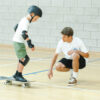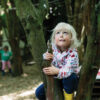How can you prepare a child for the demands of cycling on a road? Some parents will balk at letting their children near roads with traffic, let alone on them. It would be foolish to pretend there are no risks involved. However, at some point your child will use roads alone – if not on a bike, then as a pedestrian or behind the wheel of a car as a young adult. Those who are used to independence and who can make risk assessments will be safer, better road users than those who have been isolated from the outside world. It doesn’t require leaping in at the deep end. Exposure to traffic is something best done by degrees.
Co-riders and passengers
To begin with your child will travel on the road under your direct control, either as a passenger in a seat or trailer or as a co-rider on a tandem or trailer-cycle. As steering and braking are under your sole control, the only impact will be on how you cycle.
You will inevitably ride in a less swashbuckling style. Mostly it’s because you are always more careful when kids are around; it’s human nature. Partly it’s because a heavier bicycle takes longer to get up to speed and to slow down, so your riding benefits from being smoother and less stop-start. Try to anticipate junctions by arriving slowly and in the right gear for setting off. Allow the extra second or two you’ll need to pull away when judging gaps in traffic.
A child on a tandem or trailer-cycle or in a cargo bike may pick up some traffic skills from you whilst you are riding. You can reinforce this by asking an older child to see if there’s anything behind and to signal left or right when needed. (You will still have to do both these things yourself if it is safe enough.)
Tandems remain useful up to the age of 11 and possibly beyond. By that age, though, most children will want to ride solo. One reason is image. The desire to conform becomes very strong and children don’t want to be seen as ‘different’ by their friends. The tandem that was once so popular may now be seen as geeky.
Chaperoned cycling
Traffic awareness develops around the age of eight to 10 years old, which is usually when school-based cycle training tends to start. Up until that time, at least, you will need to supervise your child on roads. He or she might be a proficient cyclist and yet make misjudgements about traffic.
Before you set off
Before setting out together there are some things you need to be sure of. One is that your child can stop, start, steer and otherwise be competent at cycling – on a bike that’s roadworthy. Another is that your child will respond to your instructions, doing what you say, when you say it. Do explain the reasons for this in advance: that you’re not being bossy or cross, just careful. The final requirement is that your child knows the difference between left and right. When you say ‘go left’ it’s important your charge doesn’t cycle into the centre of the road instead.
On the road
When you’re riding, it’s best if your child leads and you cycle a bike length or half a bike length behind. That way you can watch your child at all times and call out instructions. Your child should ride towards the left side of the road, but at least 50cm out from gutter, while you ride further out, possibly taking the lane. This means traffic has to come around you and can’t cut in too close to your child, who might veer or wobble or simply be freaked out by cars passing too close.
If you need to do so, it is perfectly legal to cycle side-by-side with your child. (Many drivers are unaware that cyclists can ride two abreast, so be prepared for the odd pipped horn.) It’s worth moving forward to ride alongside as you come up to a side road. Two cyclists are more visible than one, and with both of you to pass, any side-road driver is less likely to engage in the brinkmanship of edging or accelerating out in front of you.
Give encouragement as you ride along and make your instructions calm and clear.
Information should flow both ways. In particular, your child should be taught to say ‘Stopping!’ rather than halting right in front of you without warning. Ideally, your child should also signal left before pulling in to the side. (No one uses the one-armed up-down flap that signifies slowing down nowadays, and it may only confuse drivers.)
Start on easier, less trafficked roads and work up. There will be situations in which it is easier or necessary to get off the bikes. Perhaps a hill is too steep. Perhaps a junction is too complex. In time your child will be able to ride these. For now, take it one step at a time. And remember: communication, communication, communication.
Independent cycling
Independent cycling means riding on the road. Children cycling on the pavement is illegal, but there is no criminal liability for children under the age of 10, and it is tacitly accepted by everyone that the pavement is where younger children will ride. By the age of 11, however, and perhaps two or three years earlier, (if you feel they are capable of it) most children can learn to ride safely on the road without supervision – not on all roads but certainly on roads that aren’t busy and don’t have complex junctions.
Cycle training has traditionally taken place in the later years of primary school. Not only are children ready for training then, they will soon need it. The average distance from home to secondary school is 3.3 miles in England – too far to walk perhaps, but not difficult by bike. Training has moved on quite a way since the cones-in-the-school-playground days of the Cycling Proficiency Scheme. The National Standard for Cycle Training (called Bikeability) takes place largely on the road in real-world, supervised conditions. And the training itself is no longer administered by schoolteachers but by qualified, accredited cycle instructors.
Local authorities sometimes provide free or subsidised training. Your nearest cycle training provider can fill you
in about charging policy.
Taken from www.cyclinguk.org
To see the full article visit www.cyclinguk.org/article/cycling-guide/cycling-road-children











